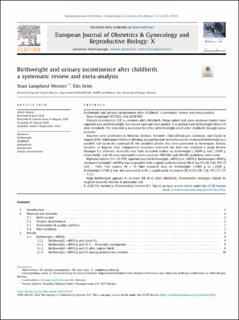Birthweight and urinary incontinence after childbirth: a systematic review and meta-analysis
Journal article, Peer reviewed
Published version

Åpne
Permanent lenke
https://hdl.handle.net/11250/2762544Utgivelsesdato
2020Metadata
Vis full innførselSamlinger
Originalversjon
European Journal of Obstetrics and Gynecology and Reproductive Biology: X. 2020, 8, 100115 10.1016/j.eurox.2020.100115Sammendrag
Urinary incontinence (UI) is common after childbirth. Many cohort and cross-sectional studies have reported data on birthweight, but results have not been pooled. It is unclear how birthweight affects UI after childbirth. The objective is to review the effect of birthweight on UI after childbirth through meta-analyses.
Searches were performed in Medline, Embase, Svemed+, ClinicalTrials.gov, Cochrane, and Cinahl in August 2016. Additional reference checking was performed. Included articles evaluated birthweight as a possible risk factor for maternal UI. We included articles that were presented in Norwegian, Danish, Swedish, or English. Two independent reviewers extracted the data and analysed it using Review Manager 5.3 software. Available data from included studies on birthweight (≥4000 g and ≥3500 g, respectively) and UI were combined in meta-analyses. PRISMA and MOOSE guidelines were used.
Eighteen studies (N = 30 070) reported data on birthweight >4000 g vs <4000 g. Birthweight>4000 g compared to weight <4000 g was associated with a significantly increased OR of any UI (OR 1.49, 95% CI 1.24 – 1.80). Five studies (N = 15 066) reported data on birthweight >3500 g vs <3500 g. Birthweight>3500 g was also associated with a significantly increased OR of UI (OR 1.26, 95% CI 1.15 – 1.37).
High birthweight appears to increase OR of UI after childbirth. Preventative strategies should be targeted towards women at particular risk.
